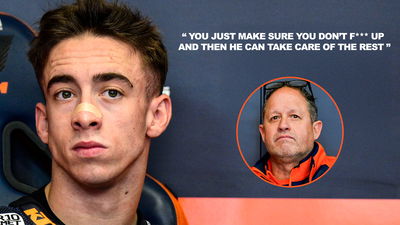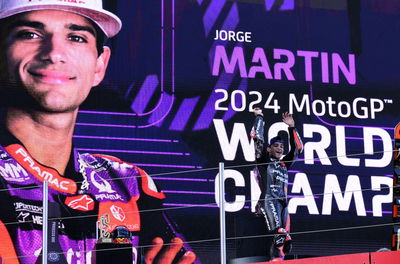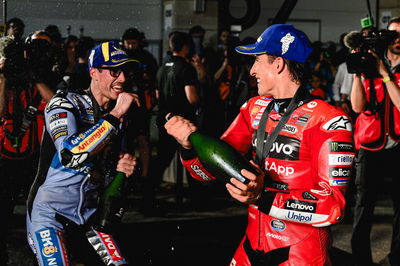EXCLUSIVE: Revealing how Pedro Acosta is “defying physics” in MotoGP
Crash.net’s Lewis Duncan sits down with Pedro Acosta’s crew chief Paul Trevathan to find out what makes MotoGP’s star rookie so good…

It’s Thursday at the Circuit de Barcelona-Catalunya and Paul Trevathan is enjoying coffee in a deserted Tech3 hospitality unit ahead of the final round of the 2024 MotoGP campaign.
The spotlight has, for the most part, been firmly on the 20-year-old he’s sat next to all year. But the no-nonsense Kiwi crew chief has been Pedro Acosta’s most important ally.
From the moment his promotion to the MotoGP class with the KTM-backed Tech3 squad was confirmed last year, expectation has been heaped on the 2021 Moto3 and 2023 Moto2 world champion. Many pegged him to win races in his MotoGP debut year, others even backed him to fight for the title.
That was all heightened on 28 November 2023 when he rode the RC16 for the first time at the post-season Valencia test.
“There was a lot of press at the time and stuff like that,” Trevathan, at the end of a stunning 2024, tells Crash.net when asked what his initial impression of Acosta was after that first test.
“But the part inside the box was the amazement of how much he could take on, how much he was already willing to gather as much information in the shortest amount of time and then put it into practice. Like all the gadgets on the bike, all the switches, it was like a Playstation: he was going through everything and the way that he could express himself and what we could tell him in the shortest period of time, and then he would go out and just do that.
“We nicknamed him the sponge at that moment because it was really quite impressive, first for that young age without that much experience when you think he’d only been in the paddock three years before he came to us. So, it was not a lot of time to be here and understand everything.
“But the willingness not to be afraid, [asking] ‘what’s these things for, is it going to make me faster? Ok, let’s go for it straight away’. So, this part was quite impressive.”
'Not a normal motorcycle to ride'

Such was Acosta’s rate of learning that at the Sepang test in February he achieved a lap time target Trevathan thought was reasonable after three days at the end of the opening day.
Qualifying eighth for his first race in Qatar, Acosta held onto points in the sprint and went all guns blazing in the grand prix to get into the podium fight early on. He faded to ninth by the chequered flag, but this was all part of the learning process and did nothing to relax any of the external expectations the world held about the Spaniard.
Acosta breached the podium for the first time in the next grand prix in Portugal, inheriting third after Maverick Vinales’ Aprilia developed an issue late on before he subsequently crashed out.
He backed it up with another in America next time out, before finishing second in the Jerez sprint. The momentum at this stage seemed endless.
But while the results on paper were impressive, Trevathan reveals what made them truly exceptional.
“These aero bikes are not a nice bit of kit,” Trevathan, who also noted that he never spoke about results expectations with Acosta all year, said.
“They’re not a normal motorcycle to ride. You’ve seen people who’ve not been on them for a while and then you see the effort and the understanding is completely different now. The aero package, the tyre problems, the temperatures, it’s quite a complicated thing at the moment and it’s not natural.
“So, you have to learn it and this is the part that I’m really impressed with him.
“If we were getting top five then I would have already been impressed. To be able to put himself in the situation where he could achieve the podium was pretty remarkable, because to do that you have to be on the front two rows.
“And to do that, at the moment, in the format that we have when already in [practice] you have to already achieve that one lap wonder early on every track we’ve been to is remarkable.
“And when you see how many times we’ve missed Q2, it’s a fantastic achievement. Maybe that’s even more impressive than getting some of the podiums, because to set up a podium you have to do it already on the Friday.
“And this is the part of understanding that he’s really trying to figure out what's really important to get the bike sorted before practice.
“Then to work on the race situation afterwards. So, it’s bloody complicated and it’s not easy, but he’s done really well at that.”
MotoGP has seen some standout rookies come through the ranks in recent years. Marco Bezzecchi was already scoring podiums with VR46 in 2022, while Jorge Martin won a grand prix in his rookie campaign in 2021. In 2019, Fabio Quartararo marked himself out as Valentino Rossi’s heir-apparent at Yamaha and as the rider most likely to beat Marc Marquez head-on in a title battle.
But none of those riders, Trevathan points out, have had to contend with the schedule as it is now, with your weekend hinging on Friday afternoon before having to qualify and then race twice each round.
Over 20 rounds, Acosta qualified outside of the top 10 only three times. He managed a pole at the Japanese GP, while his average starting spot was seventh across 20 rounds. KTM stablemate Brad Binder, who finished two points clear of Acosta in the standings, put up an average qualifying of 10th across the year.
'Defying physics'
And even when qualifying was poor for Acosta, his ability to overtake in an era where that isn’t easy saw him repeatedly charge through the pack - something that not even KTM fully understands.
“I mean it’s a question we’re still trying to ask because his riding style is really, really different,” Trevathan says. “Some of the lines he creates and how he achieves them is sometimes defying physics. And still going fast.
“He’s doing some lines that looks like a mistake that’s just not going to pay off. And he makes it work. I think it’s part inside the KTM group, which is why I think it’s hard for others to understand inside our own group, is the way he uses his body, how he can stop the bike, how he adjusts.
“To every type of situation, he comes up with another answer that’s not really in the playbook. It would be like coaching a freak basketballer who’s doing whatever and it’s like ‘how the hell are you doing this?’
“But he’s a one-man show out there at the moment. It’s nice because on my side I get to see it and I don’t have to worry about how he’s doing it. But if you’re on the other side and you’re trying to beat him and you see his data, you’re thinking ‘how the hell?’
“And then you’ve got to come up with a solution. That’s not so easy. And data doesn’t give you the answer for this. Data gives you what actually happened, a replay of that by lines.
“But actually how he done it, it’s still a big question mark on many thing we still have to be honest.”
Trevathan says Acosta’s way of riding means, as a technician, the bike just needs to be “90%” because “he’ll grab that extra 10% out of it. So, you just make sure you don’t fuck up and then he can take care of the rest”. Perhaps this could become an issue later down the line in terms of bike development for KTM - mimicking the issues Honda faces in Marc Marquez’s golden years - but that’s a problem for another day.
'When I need you I’ll ask'
What’s evident from this perspective is that, when the bike isn’t quite right, Acosta, despite his sickeningly young age, has a level-headedness even some veterans don’t possess.
“His calmness in the box, he’s never once revved,” Trevathan says when asked to compare him to other riders in KTM’s roster.
“I’m sure his in-laps have been some swearing and cursing going on, because he’s quite an open character, but when it comes to the professionalism inside the box he’s outstanding. And he’s never pointing the finger at anything.
“There’s the story that we never change the bike a lot, and it’s true. But the fact was that many times I’ve said ‘look mate, I’m here’.
“And he said ‘yeah, but when I need you I’ll ask. But let me first do what I can’.
“And this is the learning curve that us as a company, and even me as a technician, to understand that if I change something between a session and then he puts half a second on top of it, then is it the bike or is it me?
“So, in the end you’re just counteracting each other. So, it’s better to say ‘ok, do your thing and then when you’re in the shit, come and let me know’. And we’re working in this way and it’s really, really nice.”
'Unhealthy lifestyle'
Trevathan calls Acosta “an old soul in a young body” in the way he views the world. That stems from his upbringing, being the son of a fisherman and taught that he either works hard at bike racing or he has to go and get a proper job like his father’s. Not only the speed he has, but that humility has set a new template for what a MotoGP rookie should be.
“He’s even told me that, to be honest, this is a really unhealthy lifestyle,” Trevathan reveals.
“This MotoGP paddock and the pressure we put ourselves under and all that stuff is really unhealthy. And it’s not something that anyone would want their child to do, or anyone wants to do for a long time.
“But he said this is what I’m about and this is what I want to achieve, so this is what I’m doing. So, when you see a 20-year-old telling you these types of sentences it’s crazy.
“Now for a rookie coming up, he’s set the bar bloody high, because I would say the level of what Augusto [Fernandez] did was fantastic, and it was what you expected in today’s era of learning the bikes, learning the class. But this little man [Pedro] just went to another level.”
All of that proved pivotal in the middle of the season. The podiums continued after the Spanish GP sprint in the Catalan and Italian GP sprints, but from the Dutch GP the momentum slowed. It all came to a head at the Austrian GP, where he qualified 14th on KTM’s home soil, finished pointless in 10th at the sprint and struggled to 13th in the grand prix.
Trevathan admits his crew thought they could set up the bike “in a better way” for braking performance through the electronics. But this “took away a skill” Acosta made his own and led to his struggles.
All it took to get back on the right track, though, was a long car ride from Spielberg to Misano, a WP Moto2 test and a common understanding between Acosta and Trevathan. And, ultimately, it was an experience that strengthened Acosta as a rider.
“It wasn’t only him,” he says about the mid-season form dip. “It was also us trying to understand where we could be better. I wouldn’t say it was so much more on pure geometry or setting of the bike that way. It was more electronics set-up and things like this where we tried to push the envelope in the way we thought we needed. And we went that way to try to improve it.
“Looking back, we went through that and I think it was probably the best thing we did do because he had enough character in himself to say ‘fuck, I’m lost now, I don’t understand, I can’t ride the way I want to ride’.
“So then we reverted to some of the points after Spielberg, where we hit rock bottom, where that was a bloody horrendous weekend. And then at that time we decided to do a WP test and ride the Moto2 bike in Misano.
“So, me and Pedro drove down from there [Spielberg] to Misano. And we started speaking in the car. And at that point my strategy engineer was also going to come to Misano, because he wanted to spend a couple of days with Pedro as well.
“And it was just the perfect timing, where we’d spent 12 hours in the car together, talking about shit, next day him riding the Moto2 bike and enjoying himself, then stopping and then starting to talk about the situation again.
“And then we really started to pinpoint where maybe we’d gone wrong, especially for his style. So, from that point that was the moment I think we made a reset and put things back to the style we thought would be suiting each other, and then we started to go back again on things.
“So, it wasn’t only him with the dip-off. [It was] Everyone. Not because we wanted to do that, but purely we went the wrong way.”
From the following round at Aragon, Acosta was back to his best. A brace of podiums from second on the grid showed the rest had worked. The pace carried on into the Misano double-header, though his top five race pace was undone by mistakes. He ran Jorge Martin hard in the Indonesian GP to finish second, while that first win may well have come when he qualified on pole in Japan had he not crashed out of both races. One more podium followed in the wet Thai GP to bring his Sunday tally for the year up to five.
From the Emilia Romagna GP to the Thailand sprint, Acosta totalled five non-scores through crashes. Those, as well as mistakes earlier in the season, ultimately stopped him from ending the year as top KTM rider in the standings. At the summer break, Acosta had scored 110 points to Binder’s 108. From the British GP to the end of the year, Acosta tallied 105 while Binder edged ahead with 109.
This goes a long way to explaining why he only rated his rookie campaign 6/10 when asked at the Barcelona finale. That’s a harsh assessment when everything is put into full view, but - as Trevathan explains - that’s just what Acosta is like.
“I think the key is to be open and straight - not bullshitting each other,” he notes. “I live in Holland and I like Dutch people for being direct and straight. And Pedro is also very, very straight and direct.
“You don’t fuck around; you get to the point quickly and it’s not about pointing the finger. You give your ideas, give your reasoning for everything, then you start double checking and looking at yourself in the mirror a bit more and [saying] ‘I don’t kind of like what I see there’.
“The key is also to know that we’re not trying to fuck each other. We’re all working for the same goals and the more you can communicate, the more direct and open, the clearer it is for those moments.”
2025 KTM factory rider
Next year Acosta steps into the factory KTM squad. The expectations on him will remain, but nothing across 2024 has appeared to faze the 20-year-old. Going toe-to-toe with Binder is a challenge he’s already proved he’s up for, while KTM simply needs to get its bike into the ball park for Acosta to take it all the way to the top.
Trevathan will stay by his side, with Acosta leaving an indelible impression on the crew chief this year that will surely see all sides of the number 37’s KTM garage firing on all cylinders.
“Even more determined,” Trevathan concludes when asked how Acosta compares now to the rider he was a year ago in his first test.
“This is clear. Even more focused. A much better toolbox of having that understanding of what is needed to really succeed in the class. I think that would probably be the best way to describe it.
“Every time he gets on a motorcycle he surprises me. And the intensity he brings to himself, to the team, to make us all want to be better.
“You can be yourself as hungry for it or as competitive as you want, but if you don’t have the guy pushing you in the same direction then the only level you can produce is the level the guy can produce on track.
“So when you have a guy like that… I always had a saying before that if a rider gives me 100% I’ll give him 120%. If the rider gives me 90%, I’ll give him 60%. But here you’ve got a guy that wants to give you 120%, it’s like ‘holy fuck!’.
“So, it becomes a life obsession to try to help the kid because that’s the way he pushes you…”












